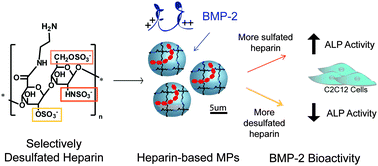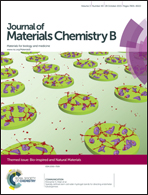Hydrolysis and sulfation pattern effects on release of bioactive bone morphogenetic protein-2 from heparin-based microparticles†
Abstract
Glycosaminoglycans (GAGs) such as heparin are promising materials for growth factor delivery due to their ability to efficiently bind positively charged growth factors including bone morphogenetic protein-2 (BMP-2) through their negatively charged sulfate groups. Therefore, the goal of this study was to examine BMP-2 release from heparin-based microparticles (MPs) after first, incorporating a hydrolytically degradable crosslinker and varying heparin content within MPs to alter MP degradation and second, altering the sulfation pattern of heparin within MPs to vary BMP-2 binding and release. Using varied MP formulations, it was found that the time course of MP degradation for 1 wt% heparin MPs was ∼4 days slower than 10 wt% heparin MPs, indicating that MP degradation was dependent on heparin content. After incubating 100 ng BMP-2 with 0.1 mg MPs, most MP formulations loaded BMP-2 with ∼50% efficiency and significantly more BMP-2 release (60% of loaded BMP-2) was observed from more sulfated heparin MPs (MPs with ∼100% and 80% of native sulfation). Similarly, BMP-2 bioactivity in more sulfated heparin MP groups was at least four-fold higher than soluble BMP-2 and less sulfated heparin MP groups, as determined by an established C2C12 cell alkaline phosphatase (ALP) assay. Ultimately, the two most sulfated 10 wt% heparin MP formulations were able to efficiently load and release BMP-2 while enhancing BMP-2 bioactivity, making them promising candidates for future growth factor delivery applications.

- This article is part of the themed collection: Bio-inspired and natural materials

 Please wait while we load your content...
Please wait while we load your content...